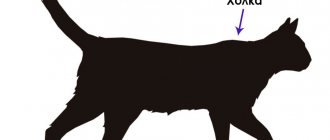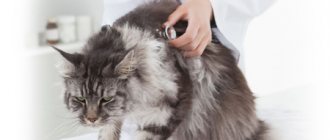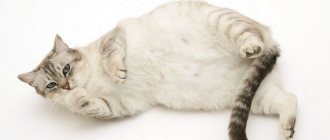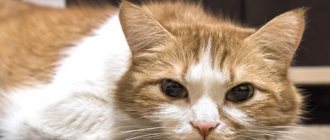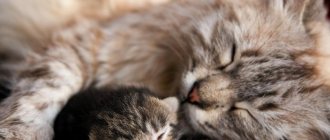Cats have a flexible fold of scruff on the back of their heads, which has a special structure, and doctors use it to treat animals. This withers in a cat is located in the place where the cervical region meets the spine. During illness, doctors inject precisely into this area. It is important for the pet owner to know about it; you need to take the animal by this fold carefully and in special cases.
Where is
The withers are the part of the animal's body located behind its head, where the neck ends and the back begins. It is this place that the common people call “shkirka”. If you want to know exactly where a cat's withers are, look at how these animals carry their babies. Pets always do this the same way. The place where a mother grabs her kittens with her teeth is the withers. Holds the cat by the scruff of the neck during mating.
Structure
So, we found out what the withers are and where they are located in a cat. How does this part of the animal’s body work? The bone base of the withers is formed by the first 5 thoracic vertebrae. They have spinous processes that give shape to this part of the body. The skin in this area of the animal is very thin and elastic. That is why kittens do not experience any pain at the moment when the mother takes them by the scruff of the neck with her teeth. The spinous processes of the vertebrae have different heights. Due to this, the animal’s withers have a slightly arched shape.
Under the skin in this place there is fatty tissue. Next come the muscles (semispinalis, rhomboid, trapezius, etc.). The joints at the withers are found only in the spine itself. A cat's shoulder blades are attached to the body solely with the help of muscles and tendons. This determines the animal’s extraordinary flexibility and its ability to make almost lightning-fast jumps.
Due to the special method of attaching the forelimbs, it is not advisable to pick up a cat by them and lift him up by weight. The animal experiences severe discomfort. It is much more correct to hold your pet behind the shoulder blades in the chest area when lifting.
A cat's withers, where the skin is not too sensitive, is still a relatively problematic place. After all, next to it is the animal’s neck. Any serious injury to this part of the body can lead to health problems for the pet or even its death. Therefore, in case of damage to the withers, owners should take their pet to the veterinarian as soon as possible.
Physiology
To understand whether or not you can pick up a cat by the scruff of the neck, you need to understand their physiology. Mother cats often carry their kittens by the scruff of the neck. Small, at this moment they resemble a funny fluffy toy, and not a real animal. But a person is not a mother cat. People think that if a cat can do it, then so can they, but this is not true. Firstly, the cat does this very carefully and not often. Secondly, she is carrying a small kitten, not an adult animal.
Kittens have softer, more elastic, pliable skin and muscles that have not yet fully developed. That is why the kitten does not hurt when it is carried. But as a cat grows, its skin becomes less elastic and rougher. The weight of the animal increases and therefore it is often impossible to pick up an already adult cat by the scruff of the neck.
- This is a lot of stress on the skin, which can stretch too much if this is done from an early age of the animal. In some cases of particularly clumsy lifting, tears may appear in the skin.
- The muscles of an adult cat are already well formed. The animal may begin to wriggle out and cause harm to itself. But even if the cat does not wriggle out, such an action can pull his neck muscles.
- Due to the significant weight of the cat, the skin can press on his throat, and he will begin to choke. And this will lead to panic in the animal and aggressive actions. This happens rarely, but it is also possible.
- In rare cases, if you sharply pull a cat by the scruff of the neck, it is possible that the spine may be damaged.
Advantage of drops
Until recently, fleas could only be removed from a cat using various types of shampoos. Today, pet stores sell all kinds of sprays against parasites, as well as drops in capsules. When using the latter, the medicine is usually applied precisely to the withers of the animal. This method guarantees that the cat will not lick the drug, get it with its paw and get poisoned. It’s clear where the cat’s withers are. Essentially, this is the highest point of the back. Therefore, after application, the medicine is distributed relatively evenly by gravity over the animal’s back and sides, which ensures the best effect. Of course, for the drug to be as effective as possible, it must be used correctly.
Veterinary meaning of the scruff
Domestic cat: what is it, description, taxonomy
Veterinary specialists have also found their importance in the withers, since a large number of anti-parasite drops are applied specifically to this area of the cat’s body. And all because the skin tissue between the shoulder blades is quite difficult to reach, which is an important factor. Medicines that combat the occurrence of parasites are quite toxic due to their chemical composition, and if a cat licks the medicine, it can simply get a parasite.
The animal becomes practically paralyzed if certain areas of the scruff of the neck are affected.
The animal's scruff also has another useful meaning. Since the withers are the most insensitive place, veterinarians in most cases give preference to it for painful and painless injections. In this case, the cat practically does not feel the needle, since there are practically no nerve endings in this area.
Note! The scruff constantly moves, and this promotes better absorption of the drug into the animal’s body. This is useful for subsequent recovery and rehabilitation.
Preparing for treatment
Thus, now the reader knows where the cat’s withers are. How to find it if you need to use medication is a simple question. However, when using the drops themselves, several important rules should be followed. Firstly, the cat should not be bathed for 2-3 days before using the medicine and for 2-3 days after that. Secondly, before using the drops, the animal’s withers must be carefully examined. If there are large lesions and wounds on it, it is better not to use the medicine. If the circumstances are unsuccessful in this case, the insecticide may enter the animal’s bloodstream, which will lead to poisoning.
When performing the procedure for applying the drug, the cat should be gently held behind its back with your left hand. You should not administer medicine to an animal that is worried about something, has become playful or is angry. The cat may jerk during the procedure to escape, and the drops will fall too low on the body. As a result, the animal will subsequently be able to reach them. Wait until your pet calms down.
Precautionary measures
Flea drops, like other specialized medications, are not toxic to your pet
Despite this, when using them, precautions must be taken so as not to harm the animal. These include:
- Before using the drops, inspect the skin where they are applied. If there are open wounds, scratches or other damage on it, then the drug cannot be applied;
- It is forbidden to handle kittens that feed on their mother's milk. The cat constantly licks her babies. At the same time, she will definitely lick off the drops applied to them. This may provoke negative consequences for her health;
- The kitten is allowed to use only specialized medications. Products for adults are not recommended for use;
- The drops used should not get on the cat's nose, eyes or mouth. If this happens, they should be washed off immediately with plenty of running water. After this, it is best to show the animal to a veterinarian;
- In some cases, drugs can cause an allergic reaction. If this happens, consult your veterinarian;
- Be careful not to lick the product off, especially if it is applied in multiple places along the spine. If this happens, observe your pet's behavior. At the first symptoms of poisoning, seek help from a specialist.
Compliance with such precautions will allow you not to worry about the health of the animal during treatment. Don't neglect them
How to apply flea drops onto the withers correctly for cats
The instructions for applying the drops are simple. In order to do everything correctly:
- put on medical rubber gloves;
- feel where the cat’s withers are;
- spread the fur on the animal’s neck closer to the base of the skull;
- completely squeeze the product out of the capsule onto the skin in the area of the highest spinous process;
- lightly rub the drops so that they do not flow to the side.
After using the drug, as already mentioned, it is not recommended to bathe the animal for several days. You should also not brush your cat. And, of course, you should not stroke your pet’s head or back for a couple of days. Otherwise, the medicine may get on your hands and subsequently cause poisoning in the owner. Some types of flea medications can also irritate human skin.
Basic recommendations
Flea drops for cats are an effective and safe remedy that will quickly get rid of parasites. Today, such drugs are manufactured by various companies. When choosing, you should focus on the age and weight of your pet. Not all products are suitable for kittens and pregnant females. When using such drugs, the following recommendations must be observed:
Before applying the product, carefully read the instructions. It tells you how many drops you will need and where it is best to drop them. Most often, it is enough to apply a couple of drops to the withers. Some products are recommended to be dripped at three points along the spine; Cat drops may not be effective if your cat gets wet after using them. Therefore, for several days after treatment, do not bathe the animal or let it go outside in rainy weather; Drops can also be used for preventive purposes.
This is especially important if the cat is walking outside. In this case, it is sufficient to carry out the treatment once every six months; The product can only be applied to dry skin; Before using such products, it is better to consult a veterinarian, as they have some contraindications.
Following these recommendations will make the use of drops safe. The main thing is to start treatment as early as possible. Remember that a cat suffers greatly from a flea bite.
What is withers? Convenient place for injections
A very common medical procedure for treating animals is subcutaneous injections. Such injections are less painful than intramuscular ones and provide a high speed of action of the drugs. For cats, subcutaneous injections are given precisely in the area of the withers. After all, here the animal’s skin is thinnest and most elastic. In addition, the cat’s skin in this area is less sensitive. And therefore, your pet will not experience much pain. In addition, as a result of grabbing a cat by the scruff of the neck, its instinct of submission is activated. Therefore, the animal resists less.
How to inject into the withers correctly
It is best to inject medicine into an animal with an assistant. This procedure is carried out as follows:
- The cat is placed on its side on the table with its back to itself. The assistant must hold the animal by the hind legs and back.
- With the left hand, the skin on the withers is pulled back with a fold.
- The injection is made by pointing the needle parallel to the back.
If there is no assistant, you don’t have to place the cat on its side. In this case, it will be more convenient to place it on the floor or on the sofa. The injection is given to the animal by pressing it with the elbow of the left hand and at the same time pulling the skin with the fingers. Finding where the cat's withers are will also be easy in this case. The injection itself is done by inserting the needle no more than a third. Only a children's or insulin syringe can be used for injection.
Application of medications
An example of the use of cat scruff for veterinary purposes is the application of drops against skin parasites such as fleas or ticks. For this purpose, medicinal products are used that affect pests. Experts choose this particular area because the animal is not able to reach it with its tongue or paw. It will not be able to lick off the drug before it is absorbed.
The scruff of the neck is the first place on a cat’s body where medications are injected.
The scruff is also used when administering subcutaneous injections, which include medications or various vitamins to improve the pet's immunity. The choice of this area is explained by several factors:
- the scruff of the neck has the smallest number of nerve endings, so injections are completely painless;
- The fat layer present at the withers is distinguished by its loose structure and ability to quickly absorb medications, distributing them throughout the animal’s body.
Important! When injecting at home, it is advisable to select an insulin syringe, since it has a fairly short needle that is not able to penetrate more than 1/3, thereby without injuring the cat.
Injuries in the withers area
Most often, such damage occurs in animals during mating. A cat rarely leaves wounds on a cat’s withers, but sometimes this does happen. To treat the area around the lesion, you first need to trim the fur. Next, you should rinse the wound with hydrogen peroxide. You can also use Terramycin spray or brilliant green.
Old wounds with signs of inflammation should be treated with antibiotics. This could be, for example, Misofenom ointment. It is applied to a napkin and applied to the wound. Then a bandage is applied. But, of course, it’s better not to let things get to the point of inflammation. If the damaged area is swollen and red, or there is pus coming out of it, you should immediately contact a specialist.
Installing an IV for a cat
The basic rule for installing an IV, as with any other medical intervention, is thoughtfulness and sterility.
To fulfill the first rule, determine in advance the location of the procedure: a table with a bedding must be prepared in the room on which you will fix the pet; you need good lighting and an object such as a mop or cabinet handle, located at a height of 40–50 centimeters from the table, to secure the solution . In addition, it is necessary to ensure the optimal temperature of the solution. If for some reason there is no time to warm it up, after collecting the dropper, provide a deep plate with hot water through which the system tube will pass, then the drug will warm up a little before infusion. During the entire administration process, it is necessary to keep the cat under supervision, it is necessary to select the desired speed of administration of the solution and to prevent air from entering the dropper tube.
To maintain sterility, you need to wash your hands with soap and water up to the middle of the elbow, put on disposable gloves and invite an assistant to help.
Remain calm during the procedure: the owner’s feelings are transmitted to the cat.
Preparation for the procedure
To install a dropper you will need:
- medicinal product;
- tripod for fixing the bottle. Can be replaced with a pendant made from a plastic bag or bandage;
- disposable syringe;
- system for intravenous infusions (infusions);
- alcohol and cotton wool.
When all the components are collected, you can proceed directly to the procedure:
- Remove the protective cap from the lid of the medicine bottle.
- Turn it over and fix it at a height of 40–50 centimeters above the intended location of the patient.
- Treat the rubber stopper on the bottle cap with alcohol.
The intravenous infusion system consists of a needle for connection to a bottle or plastic bag with solution, a dropper, an injection rate regulator, a unit for additional injections and a needle
- Assemble the system: Lower the injection speed control wheel all the way down.
- Insert the punch into the rubber stopper on the lid of the medication bottle.
- Nearby, insert a needle from a disposable syringe or for intravenous injections, which comes with the system if the liquid will be administered through a catheter. This is necessary for air circulation.
- Press the plastic container under the punch 2-3 times. Liquid should drip from the bottle. Wait until the container is half full.
- Slowly lift the dispenser ring (speed control wheel), watching as the liquid fills the tube. The goal is to prevent air from entering.
- Follow the entire path of the liquid through the tube until it begins to pour out.
- Close the dispenser and check the system for air bubbles.
- If there are bubbles, open the dispenser again and drain the solution until they are destroyed.
- Insert the free end of the dropper into the needle that is already in the cap of the bottle. The dropper can be left in this form until the procedure begins.
Further actions depend on whether a catheter will be used to administer the medicine or not.
Video: how to assemble a dropper
Inserting an IV using a catheter
To connect an IV to a catheter in an animal's vein, follow these steps:
- With the help of an assistant, place the animal on the table, calm it down, secure it by wrapping it with pre-prepared bedding.
- Clean the outer parts of the catheter with cotton wool soaked in alcohol.
- Fill the syringe with 2 ml of saline solution.
- Remove the protective cap from the middle port of the catheter.
- Insert a syringe without a needle into it and inject the solution. A small amount of solution should remain in the syringe to prevent air bubbles from entering the vein. Further actions depend on how well the solution flows: If the usual force when pressing the syringe plunger is not enough, then a blood clot has formed in the catheter. Try to dissolve it by introducing a mixture of heparin and saline into the upper port in a ratio of 0.1 ml of the former to 1 ml of the latter. Repeat the injection of the solution through the middle port. If everything is still the same, then it is best to contact your veterinarian to replace the catheter.
- If the solution goes well, you can continue the procedure.
Video: how to connect the system to a catheter
Installing an IV without using a catheter
To install an IV without using a catheter, follow these steps:
- With the help of an assistant, place the animal on the table, calm it down, secure it by wrapping it with pre-prepared bedding.
- Shave the fur on the paw at the fold and slightly below.
- Wrap the paw tightly above the fold with a tourniquet or bandage. Wait for the vein to swell.
- Insert an intravenous needle parallel to the paw. Better than the butterfly type.
The butterfly uses a very thin needle, which will reduce the likelihood of injury to the vein
- Remove the clamp or bandage. If everything is done correctly, blood will begin to drip from the end of the needle.
- Open the dropper with the wheel and watch the speed at which drops appear in the plastic container. It should be 1-2 drops per second, depending on the density of the solution; the higher it is, the slower the liquid needs to drip.
- Secure the needle with an adhesive tape at a distance of a centimeter from the injection site.
- If you need to add another drug, fill the syringe with it and inject the medicine into the elastic band (node for additional injections).
Completing the procedure
When the liquid begins to flow through the system tube or the required amount remains in the bottle, close the dropper with the wheel and perform the following steps:
- with a catheter installed, remove the system from it. Close the middle port of the catheter with a clean stopper, and drop a mixture of heparin and saline into the top port (drawn into a syringe at the rate of 5 ml of 0.5 ml of heparin per 4.5 ml of saline) to prevent the formation of blood clots. Bandage the catheter and secure the bandage with a bandage;
- if there is no catheter, peel off the plaster securing the tube with the needle, apply a cotton swab soaked in alcohol to the puncture site and remove the needle. Bandage or secure the area with a bandage.
Interesting fact
Where the withers are located in cats, and what injuries the pet most often receives in the scruff area is therefore clear. As you can see, this place is significant for the animal’s body. Among other things, the withers also have one very interesting property. The fact that kittens calm down immediately after a cat takes them by the scruff of the neck, hang calmly and do not try to escape is well known. Why is this happening? Why do kittens hang in their mother’s teeth like lifeless “bags” in the fetal position? In fact, this behavior is primarily due to the presence of a special zone in the cat’s brain. As soon as the animal is taken by the scruff of the neck, certain impulses begin to flow from here, calming it. At the same time, the cerebellum gives the cat a signal to take a characteristic pose.
Scientists believe that such a mechanism was developed in these animals during the process of evolution. After all, a cat will not simply transfer its offspring from place to place. She acts in this way only when her children are in any danger. A screaming, attention-grabbing kitten in nature simply has a significantly reduced chance of survival.
comments
Vitaly I train according to your recommendations: stand, sit, front. Alexey I do not agree with the opinion that modern pets are stupid animals to which only the most basic version of training can be applied. Kysa is fully aware of what the withers are, how it affects her, and has a personal opinion on various facts and stimuli. For example, cats that have experienced serious trauma and were treated by a veterinarian are treated much better
Perhaps the most important thing is consistency, completeness and extremely equal treatment - as much as you think possible. Believe me, the majority of people are not much superior to the thinking capabilities of cats - they just don’t have a developed language or writing, so their brain is developed “in the other direction” - for example, they understand non-verbal signals an order of magnitude better than people
Natalya Delnaya become. She herself used the withers of her cats for the purpose of raising them. At one time, when I adopted my first cat, in order to understand its character, I stocked up on books on animal psychology. And from there I learned that in order to be able to become an authority for a cat, you need to become the eldest cat in the pride
This is very important, then the cat will respect and trust the owner. That's how I built relationships
But then I came across a seasoned street cat who somehow survived the injury. The cat was already at least a year old, he had ear mites and established street habits, and he was also a real big fighting cat. I suffered with him for almost a year. Our wars were serious, he did dirty tricks and at the same time he brazenly looked into my eyes. This is where the withers came in handy. It was thanks to the fact that I began to grab him by the withers and press him to the floor that I did not receive scratches from his huge claws, and I made it clear who was boss in the house. And the cat obeyed. We have been living in perfect harmony for 8 years now.
